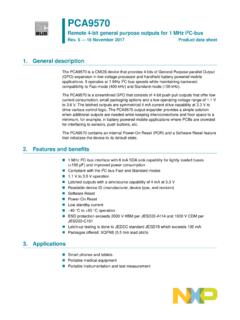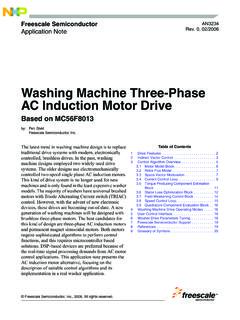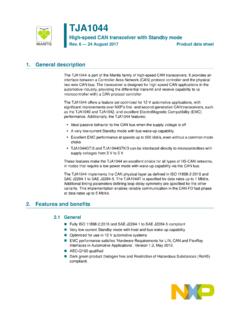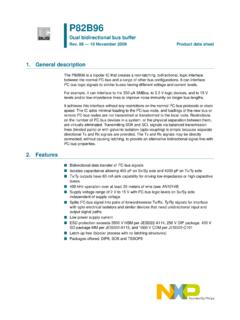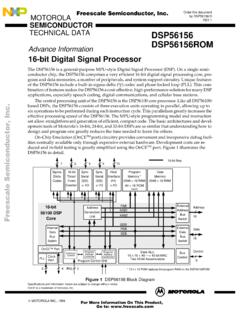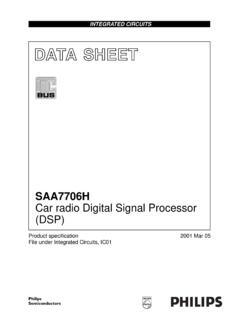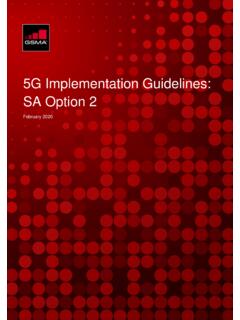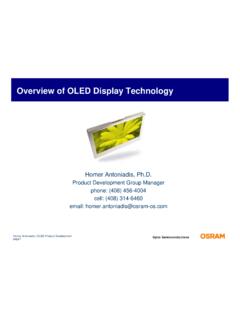Transcription of Overview of the 3GPP Long Term Evolution Physical Layer
1 White Paper Overview of the 3 GPP long Term Evolution Physical Layer Jim Zyren Dr. Wes McCoy, Technical Editor Document Number: 3 GPPEVOLUTIONWP. Rev 0. 07/2007. Overview long Term Evolution (LTE) is the next step forward in cellular 3G services. Expected in the 2008 time frame, LTE is a 3 GPP standard that provides for an uplink speed of up to 50 megabits per second (Mbps) and a downlink speed of up to 100 Mbps. LTE will bring many technical benefits to cellular networks. Bandwidth will be scalable from MHz to 20. MHz. This will suit the needs of different network operators that have different bandwidth allocations, and also allow operators to provide different services based on spectrum. LTE is also expected to improve spectral efficiency in 3G. networks, allowing carriers to provide more data and voice services over a given bandwidth. This technical white paper provides an Overview of the LTE Physical Layer (PHY), including technologies that are new to cellular such as Orthogonal Frequency Division Multiplexing (OFDM) and Multiple Input Multiple Output (MIMO) data transmission.
2 Contents 1 Introduction 1 Physical Signals 17. LTE Design Goals 1 Transport Channels 18. 2 LTE Basic Concepts 2 Mapping Downlink Physical Channels to Transport Channels 19. Single Carrier Modulation and Channel Equalization 2 Downlink Channel Coding 19. OFDM 3 Uplink 20. Disadvantages of OFDM 5 Modulation Parameters 20. OFDMA 7 Multiplexing 20. Comparison of OFDMA with Packet- Uplink Physical Channels 20. Oriented Protocols 7. Uplink Physical Signals 21. OFDMA and the LTE Generic Frame Uplink Transport Channels 21. Structure 8. Mapping Uplink Physical MIMO and MRC 10. Channels to Transport Channels 22. SC-FDMA 13. Coding 22. 3 LTE Physical Layer 14. MB-SFN 22. Downlink 15. 4 Conclusions 22. Modulation Parameters 15. 5 References 23. Downlink Multiplexing 16. 6 Acronyms and Abbreviations 24. Physical Channels 16. 1 Introduction The 3 GPP long Term Evolution (LTE) represents a major advance in cellular technology.
3 LTE is designed to meet carrier needs for high-speed data and media transport as well as high-capacity voice support well into the next decade. It encompasses high-speed data, multimedia unicast and multimedia broadcast services. Although technical specifications are not yet finalized, significant details are emerging. This paper focuses on the LTE Physical Layer (PHY). The LTE PHY is a highly efficient means of conveying both data and control information between an enhanced base station (eNodeB) and mobile user equipment (UE). The LTE PHY employs some advanced technologies that are new to cellular applications. These include Orthogonal Frequency Division Multiplexing (OFDM) and Multiple Input Multiple Output (MIMO) data transmission. In addition, the LTE PHY uses Orthogonal Frequency Division Multiple Access (OFDMA) on the downlink (DL) and Single Carrier Frequency Division Multiple Access (SC-FDMA) on the uplink (UL).
4 OFDMA allows data to be directed to or from multiple users on a subcarrier-by-subcarrier basis for a specified number of symbol periods. Due to the novelty of these technologies in cellular applications, they are described separately before delving into a description of the LTE PHY. Although the LTE specs describe both Frequency Division Duplexing (FDD) and Time Division Duplexing (TDD) to separate UL and DL traffic, market preferences dictate that the majority of deployed systems will be FDD. This paper therefore describes LTE FDD systems only. LTE Design Goals The LTE PHY is designed to meet the following goals [1]: 1. Support scalable bandwidths of , , , and MHz 2. Peak data rate that scales with system bandwidth a. Downlink (2 Ch MIMO) peak rate of 100 Mbps in 20 MHz channel b. Uplink (single Ch Tx) peak rate of 50 Mbps in 20 MHz channel 3. Supported antenna configurations a. Downlink: 4x2, 2x2, 1x2, 1x1.
5 B. Uplink: 1x2, 1x1. 4. Spectrum efficiency a. Downlink: 3 to 4 x HSDPA Rel. 6. b. Uplink: 2 to 3 x HSUPA Rel. 6. 5. Latency a. C-plane: <50 100 msec to establish U-plane b. U-plane: <10 msec from UE to server 6. Mobility A. Optimized for low speeds (<15 km/hr). B. High performance at speeds up to 120 km/hr C. Maintain link at speeds up to 350 km/hr 7. Coverage a. Full performance up to 5 km b. Slight degradation 5 km 30 km c. Operation up to 100 km should not be precluded by standard Freescale Semiconductor, Inc. Overview of the 3 GPP long Term Evolution Physical Layer 1. 2 LTE Basic Concepts Before jumping into a detailed description of the LTE PHY, it's worth taking a look at some of the basic technologies involved. Many methods employed in LTE are relatively new in cellular applications. These include OFDM, OFDMA, MIMO and Single Carrier Frequency Division Multiple Access (SC-FDMA).
6 Readers familiar with these technologies can skip this material and proceed directly to Section 3. LTE employs OFDM for downlink data transmission and SC-FDMA for uplink transmission. OFDM is a well-known modulation technique, but is rather novel in cellular applications. A brief discussion of the basic properties and advantages of this method is therefore warranted. When information is transmitted over a wireless channel, the signal can be distorted due to multipath. Typically (but not always) there is a line-of-sight path between the transmitter and receiver. In addition, there are many other paths created by signal reflection off buildings, vehicles and other obstructions as shown in Figure Signals traveling along these paths all reach the receiver, but are shifted in time by an amount corresponding to the differences in the distance traveled along each path. Single Carrier Modulation and Figure Multipath is Caused by Reflections Channel Equalization Off Objects Such as Buildings and Vehicles To date, cellular systems have used single carrier modulation schemes almost exclusively.
7 Although LTE. uses OFDM rather than single carrier modulation, it's instructive to briefly discuss how single carrier systems deal with multipath-induced channel distortion. This will form a point of reference from which OFDM systems can be compared and contrasted. The term delay spread describes the amount of time delay at the receiver from a signal traveling from the transmitter along different paths. In cellular applications, delay spreads can be several microseconds. The delay induced by multipath can cause a symbol received along a delayed path to bleed into a subsequent symbol arriving at the receiver via a more direct path. This effect is depicted in Figure and is referred to as inter-symbol interference (ISI). In a conventional single carrier system symbol times decrease as data rates increase. At very high data rates (with correspondingly shorter symbol periods), it is quite possible for ISI to exceed an entire symbol period and spill into a second or third subsequent symbol.
8 Figure Multipath-Induced Time Delays Result in ISI. Delayed signal rec'd via longer path ISI ISI ISI. Signal received by direct path It's also helpful to consider the effects of multipath distortion in the frequency domain. Each different path length and reflection will result in a specific phase shift. As all of the signals are combined at the receiver, some frequencies within the signal passband undergo constructive interference (linear combination of signals in-phase), while others encounter destructive interference (linear combination of signals out-of-phase). The composite received signal is distorted by frequency selective fading (see Figure ). 2 Overview of the 3 GPP long Term Evolution Physical Layer Freescale Semiconductor Figure Longer Delay Spreads Result in Frequency Selective Fading Signal Bandwidth Signal Bandwidth deep fades Multipath Distortion frequency frequency Transmitted Single Carrier Signal Received Signal Distorted by Frequency Selective Fading Single carrier systems compensate for channel distortion via time domain equalization.
9 This is a substantial topic by itself, and beyond the scope of this paper. Generally, time domain equalizers compensate for multipath induced distortion by one of two methods: 1. Channel inversion: A known sequence is transmitted over the channel prior to sending information. Because the original signal is known at the receiver, a channel equalizer is able to determine the channel response and multiply the subsequent data-bearing signal by the inverse of the channel response to reverse the effects of multipath. 2. CDMA systems can employ rake equalizers to resolve the individual paths and then combine digital copies of the received signal shifted in time to enhance the receiver signal-to-noise ratio (SNR). In either case, channel equalizer implementation becomes increasingly complex as data rates increase. Symbol times become shorter and receiver sample clocks must become correspondingly faster.
10 ISI becomes much more severe . possibly spanning several symbol periods. Figure Transversal Filter Channel Equalizer .. Adaptive Algorithm The finite impulse response transversal filter (see Figure ) is a common equalizer topology. As the period of the receiver sample clock ( ) decreases, more samples are required to compensate for a given amount of delay spread. The number of delay taps increases along with the speed and complexity of the adaptive algorithm. For LTE data rates (up to 100 Mbps) and delay spreads (approaching 17 sec), this approach to channel equalization becomes impractical. As we will discuss below, OFDM eliminates ISI in the time domain, which dramatically simplifies the task of channel compensation. OFDM. Unlike single carrier systems described above, OFDM communication systems do not rely on increased symbol rates in order to achieve higher data rates. This makes the task of managing ISI much simpler.
